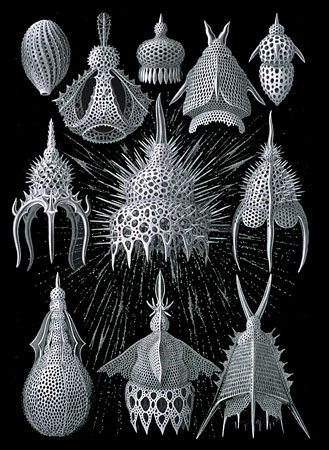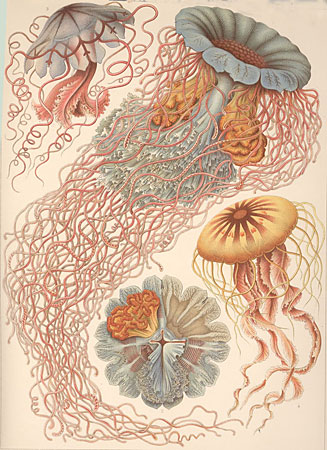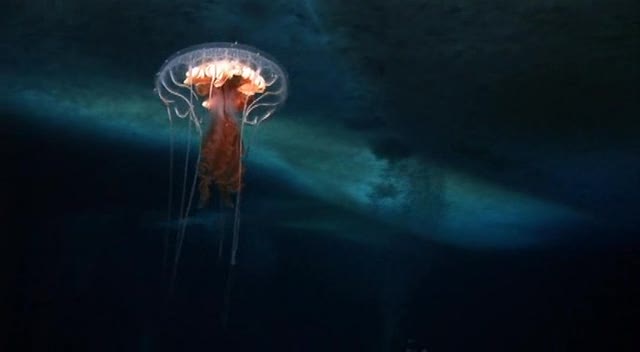
Image Credit: Ernst Haeckel
H/T: Slate
In the viz. archive, Dale quotes a 1979 interview with German filmmaker Werner Herzog, in which he insists that "if we do not find adequate images and an adequate language for our civilization with which to express them, we will die out like the dinosaurs." Re-watching Herzog’s 2007 documentary Encounters at the End of the World, which offers a strangely beautiful vision of Antarctica, I was reminded of the late-19th-century scientific drawings by German zoologist Ernst Haeckel. Both give us “new images” of the natural world through a complex mode of artistic, mystical, and scientific vision, generating what I’ll call a visual biology of the strange.
For Haeckel, stylized drawings like the radiolaria array above would help naturalists see the unity of life (and its common descent). However, both his contemporaries and modern scientists have questioned the accuracy of these illustrations, their fidelity to the specimens he collected. Despite their problematic status as scientific illustration, these images make visible an eerie vitality that connects organic life. Their artistry invokes a feeling in the viewer akin to a science-fictional alterity: these images are both familiar and strange, hence their power to alter our vision.

Image Credit: Ernst Haeckel
H/T: Slate
Similarly, Herzog’s Encounters defies existing schemes of classification. Critics have pointed to its oddball poetry, its mystical vision; in particular, it’s been understood in terms of the “absurd quest” trope that dominates Herzog’s oeuvre, including his previous documentary Grizzly Man. But its quirkiness perhaps obscures its achievement: Encounters re-envisions the nature film.
Instead of “fluffy penguins,” the camera lingers on a disoriented, perhaps “deranged,” lone penguin as it follows a determined path into the interior, toward “certain death.” The underwater footage, set to majestic but slightly dissonant choral music, takes on an element of danger, even fear, when juxtaposed with researcher Sam Bowser’s science-fictional descriptions of this “horribly violent world,” with “worm-type things with horrible mandibles” that drove our ancestors to flee in terror to the land.

Image Credit: Encounters at the End of the World
The film also insists on human subjects and interventions as part of the Antarctic landscape: the camera turns with equal curiosity to the continent’s temporary human inhabitants and to the “bleak Motel 6 drabness” of McMurdo Research Base. Instead of the researcher as talking head, we see the nutritional ecologists who study the feeding patterns of Weddell seals enact a performance-art piece: they slowly crouch down to listen to the ice above the Ross Sea, accompanied by the “inorganic,” Pink-Floyd-like sounds of underwater seal recordings.
At the risk of mere gushy praise versus cool intellectual distance: I confess that I left the film with a sense of gratitude for its vision of scientific inquiry as deeply motivated by aesthetic appreciation and even mystical yearnings--from the glaciologist who dreams that he hears the cry of the iceberg B15 to the physicist who describes his investigations of the neutrino as an attempt to contact “some spirit or god” inhabiting a separate universe.
The apocalyptic resonance of the film's title points, ultimately, to the urgent need for "new images" of science. To reiterate the sentiments of last week's post, perhaps environmental activism must begin not with cliched images of cuddly, distressed polar bears trapped on ice floes, but with visions of wonder, with a sense of mysterious beauty, with the biology of the strange exemplified by Haeckel's studies of organic forms and Herzog's Encounters.
Comments
Ernst Haeckel and the Hyperbolic Crochet Reef
The Institute for Figuring names Ernst Haeckel as its "Patron Saint" for its sublime project, the creation of crocheted reefs currently being exhibited around the world (http://www.theiff.org/reef/index.html). These crocheted "corals" are perfect examples of the convergence of visual art and science. The crochet stitches used to create them are the only easy method thus far found by mathematicians to illustrate hyperbolic space. And "it turns out that many marine organisms embody hyperbolic geometry in their anatomies - among them kelps, corals, sponges, sea slugs and nudibranchs. Thus the Crochet Reef not only looks like a coral reef, it draws on the same underlying geometry endemic in the oceanic realm." http://www.theiff.org/reef/reef1b.html You can see many photos of the crocheted reefs on the website of the Institute for Figuring. And you can see many beautiful individual contributions to the reefs by looking through the galleries listed under "Crochet Reef Contributors." First in this list is Ernst Haeckel. There is also a TED Talk by one of the founders of the reef project at http://www.ted.com/talks/margaret_wertheim_crochets_the_coral_reef.html Anne Bobroff-Hajal
Pet nature
A friend and I came up with the word "pet nature," when we were looking at an architecture magazine showcasing multi-million dollar houses with outdoor patios blending seamlessly into the landscape. Some of the locales were very remote and wild. We thought the ambient-lit, scored, and terraced patios were as lovely for an elegant cocktail hour as they were for a bear mauling, or landslide. What ever happened to a fence to keep nature out? My friend and my discussion was about how nature is dangerous, unpredictable, and powerful: not our pet, nor 'cuddly' friend .
I *love* the post here, which I read as being less about the power of nature and more about nature's quixotic, unnerving textures, its mind-altering specificities (via these artistic renderings). I think that is a much more complex way to look at it, although the idea of "pet nature" is still quite descriptive when you go into Whole Foods or buy an eco-friendly product. I haven't read anything else like this post, so I wonder whether there are parts of the environmental movement talking in the same way.